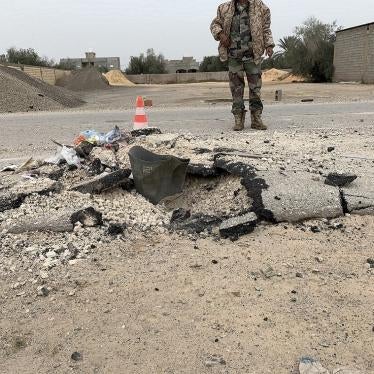(Washington, DC) – An armed group and affiliates fighting for control of the Libyan capital, Tripoli, appear to have used antipersonnel landmines and booby traps there in late May 2020, Human Rights Watch said today.
“Any use of internationally banned landmines is unconscionable,” said Steve Goose, arms division director at Human Rights Watch and chair of the International Campaign to Ban Landmines, the Nobel Peace Co-Laureate. “Those fighting in Tripoli should halt using landmines and start clearing them to avoid further harm to life and limb.”
Fighters affiliated with the Libyan Arab Armed Forces (LAAF) commanded by Khalifa Hiftar, including foreign forces, appear to have laid mines as they withdrew from southern districts of the city. For months, LAAF and affiliated forces have been fighting the internationally recognized Tripoli-based Government of National Accord (GNA).
During the 2011 revolution against Muammar Gaddafi, General Hiftar pledged that armed forces under his command would never use landmines because the indiscriminate weapons cannot distinguish between fighters and civilians. General Hiftar should publicly renew this pledge and instruct fighters under his command and foreign fighters supporting the LAAF to stop using landmines and destroy any stocks in their possession, Human Rights Watch said.
On May 25, the United Nations Support Mission in Libya (UNSMIL) expressed concern at reports that residents of Tripoli’s Ain Zara and Salahuddin neighborhoods have been killed or wounded by improvised explosive devices placed “in/near” their homes. A relative stated that Zakaria al-Jamal died in an explosion on May 22, while checking his family’s home in Salahuddin. A graphic video posted on Twitter on May 25 shows a man named Muhammad Daleh who was killed and whose brother was lying heavily injured on the ground after reportedly trying to dismantle explosive devices in Tripoli.
GNA-aligned forces shared photographs on Twitter on May 29 showing four types of antipersonnel landmines manufactured in the Soviet Union or Russia and claiming they were “laid by the Wagner mercenaries,” a Kremlin-linked private military company that supports the LAAF in the Ain Zara, Al-Khilla, Salahuddin, Sidra, and Wadi al-Rabi districts of Tripoli. Other photographs shared on social media show mines equipped with tripwires and mines used as triggers to detonate larger improvised explosive devices. Video footage shows various explosive charges used to booby trap homes, including antivehicle mines, paired with various types of fuzes and a mix of electronic timers, circuit boards, and modified cell phones.
These devices were assembled and used in a manner intended to be detonated by the presence, proximity, or contact of a person, Human Rights Watch said. They are able to incapacitate, injure, or kill one or more people. Such victim-activated explosive devices are prohibited by the Mine Ban Treaty, regardless of whether the antipersonnel mine was assembled in a factory or improvised from locally available materials.
Libya’s governance has been divided between the two entities engaged in an armed conflict since April 2019: the GNA and the rival Interim Government affiliated with the LAAF in eastern Libya. Despite an arms embargo, the United Arab Emirates, Egypt, Jordan, and Russia have provided the LAAF with military support. Foreign fighters from Chad, Sudan, and Syria as well as fighters from a Russia-supported private company also support the armed group. The GNA’s main military backer is Turkey, with additional support from foreign fighters from Chad, Sudan, and Syria.
Libya is not one of the 164 nations that have committed to a comprehensive prohibition of antipersonnel mines, clearance, and victim assistance. The previous government of Muammar Gaddafi expressed interest in the Mine Ban Treaty but made no effort to join it. After Human Rights Watch documented landmine use by Gaddafi forces in 2011, Hiftar and other commanders of armed groups committed to never use landmines and to provide mine clearance, risk education about the dangers of the mines, and victim assistance.
The Gaddafi government acquired and stockpiled millions of landmines that were subsequently seized by anti-government fighters and civilians after storage facilities were abandoned or left unsecured in 2011. The antipersonnel mines discovered in Tripoli in May are of Soviet and Russian origin and include POM-2, PMN-2, and olive drab-colored MON-50 mines that were not previously recorded in Libya, suggesting these landmines may have transferred into the country in recent years.
Libya is affected by landmines and explosive remnants of war dating back to World War II. Since then, landmines and explosive remnants of war in Libya have caused at least 3,252 casualties, according to Landmine Monitor.
“This latest landmine use is adding to Libya’s already considerable burden of uncleared mines, abandoned ordnance, unexploded ordnance, and danger for Libyans for years to come,” Goose said.
|
News Release
Libya: Landmines Left After Armed Group Withdraws
Victim-Activated Explosive Devices Endanger Human Lives
Your tax deductible gift can help stop human rights violations and save lives around the world.
Region / Country
Most Viewed
-
November 12, 2025
“You Have Arrived in Hell”

-
-
November 25, 2024
Haiti: Scarce Protection as Sexual Violence Escalates
-
November 25, 2019
A Dirty Investment

-
March 20, 2025
Human Rights Watch declaration on prison conditions in El Salvador for the J.G.G. v. Trump case




